When it comes to indulging in exquisite seafood delicacies, cold smoked salmon is a true gastronomic delight. The process of cold smoking salmon involves carefully curing and smoking the fish at low temperatures, resulting in a delicate texture and a rich, smoky flavor. In this article, we will explore the fascinating process behind cold smoked salmon and the reasons why it is considered a culinary masterpiece.

What is Cold Smoked Salmon?
Cold smoked salmon is a type of cured fish that undergoes a unique smoking process. Unlike hot smoking, which cooks the fish at high temperatures, cold smoking preserves the rawness of the salmon while infusing it with a subtle smoky taste. This traditional method originated in Scandinavia, where preserving fish was essential for survival in harsh winter conditions.
The process begins with selecting the freshest salmon, preferably wild-caught, and carefully cleaning and filleting it. The fish is then coated with a mixture of salt, sugar, and sometimes spices, which acts as a curing agent. This curing process not only enhances the flavor but also helps to preserve the fish.
The Cold Smoking Process
Once the salmon is cured, it is ready for the cold smoking process. Cold smoking involves exposing the fish to smoke at a temperature range of 68°F to 86°F (20°C to 30°C) for several hours. The smoke is usually generated by smoldering hardwood chips, such as oak, beech, or maple, which release a gentle, aromatic smoke.
During the smoking process, the salmon is hung in a smokehouse or placed on racks, allowing the smoke to penetrate the fish and infuse it with flavor. The low temperature ensures that the salmon remains raw, while the smoke adds a distinct smoky taste. This slow and controlled process can take anywhere from 12 to 48 hours, depending on the desired intensity of flavor.
Why is Cold Smoked Salmon Considered a Culinary Masterpiece?
Cold smoked salmon is highly regarded in the culinary world due to its exceptional taste and texture. The gentle smoking process imparts a subtle smokiness that perfectly complements the natural flavors of the salmon. The fish retains its moistness and delicate texture, making it a favorite ingredient in a wide range of dishes.

The cold smoking process also enhances the shelf life of the salmon. By curing and smoking the fish, harmful bacteria are inhibited, allowing the salmon to be stored for longer periods without compromising its quality. This preservation method was particularly important in the past when refrigeration was not readily available.
- Is cold smoked salmon safe to eat?
- How long does cold smoked salmon last?
- Can I cold smoke salmon at home?
Yes, cold smoked salmon is safe to eat. The curing and smoking process helps inhibit the growth of harmful bacteria, making it a safe and delicious choice.
Cold smoked salmon can last for several weeks when properly stored in the refrigerator. However, it is best consumed within a few days of purchase for optimal freshness.
While it is possible to cold smoke salmon at home, it requires specialized equipment and careful monitoring of temperature and smoke levels. It is recommended to seek guidance from experts or purchase cold smoked salmon from reputable suppliers.
In conclusion, the cold smoking process for salmon is a meticulous and flavorful art. This traditional method preserves the rawness of the fish while infusing it with a delicate smoky taste. Cold smoked salmon is not only a culinary masterpiece but also a versatile ingredient that can elevate a variety of dishes. Whether enjoyed on its own, in salads, or as a topping for canapés, cold smoked salmon is a true delicacy that seafood enthusiasts can savor.
If you want to know other articles similar to The art of cold smoked salmon: a delicate culinary masterpiece you can visit the Culinary category.


Related Articles